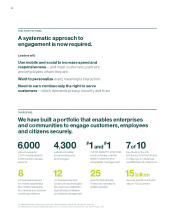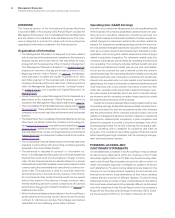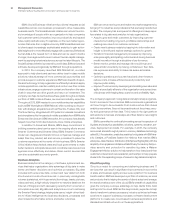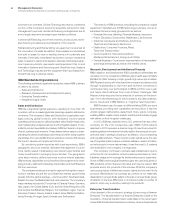IBM 2013 Annual Report Download - page 30
Download and view the complete annual report
Please find page 30 of the 2013 IBM annual report below. You can navigate through the pages in the report by either clicking on the pages listed below, or by using the keyword search tool below to find specific information within the annual report.29
Management Discussion
International Business Machines Corporation and Subsidiary Companies
The company creates value for clients and solves business prob-
lems through integrated solutions that leverage information technology
and deep knowledge of business processes. IBM solutions typically
create value by reducing a client’s operational costs or by enabling
new capabilities that generate revenue. These solutions draw from
an industry-leading portfolio of consulting, delivery and implementa-
tion services, enterprise software, systems and financing.
Strategy
IBM’s strategy is one of innovation, transformation and a constant
evolution to higher value. The company delivers innovative solutions,
software and infrastructure to improve client outcomes. The company
helps enterprises apply technology to capture new value across their
entire organizations, and it provides a differentiated client experience
through a highly engaged and skilled global workforce and a broad
ecosystem of partners. The ultimate goal of this strategy is to deliver
on IBM’s purpose of making our company essential to clients,
employees, partners, investors and communities.
Three strategic imperatives shape our approach as we continu-
ously transform IBM and align the company for higher value.
1. Make Markets by Transforming Industries and
Professions with Data
The emergence of big data as the world’s new natural resource is the
phenomenon of our time. It is being fueled by the proliferation of mobile
devices, the rise of social media and the infusion of technology into all
things and processes. Today, enterprises must harness data to create
competitive advantage. The value for enterprises increases as they
apply more sophisticated analytics across more disparate data
sources. Their real-time use of data will increasingly become a com-
petitive differentiator. Enterprises will also need cognitive computing
capabilities as data continues to grow in all dimensions. Therefore,
IBM’s strategy is to make markets by transforming industries and pro-
fessions with data. The company has invested more than $22 billion,
including $15 billion on more than 30 acquisitions, to build its capabili-
ties in big data and analytics. One third of IBM’s research is focused
on data, analytics and cognitive computing. The company is investing
$1 billion in Watson solutions to build out the next era of cognitive
systems and services. In 2013, the company realized $15.7 billion in
business analytics revenue. The original target for this business was
to achieve $16 billion in revenue in 2015—as a result of this perfor-
mance, the company has taken its 2015 objective for business
analytics revenue to $20 billion.
2. Remake Enterprise IT for the Era of Cloud
Enterprises are increasingly relying on cloud, which is being fueled
by abundant bandwidth, the emergence of standards and the
demand for consumability. They are benefitting from cloud by using
it to transform their IT and business processes into digital services,
to reinvent their core business processes and to drive innovation.
Enterprises are integrating public and private clouds with back-end
systems to create hybrid, dynamic environments. They will increas-
ingly need to manage their cloud environments with the same rigor
as an on-premise datacenter. Therefore, IBM’s strategy is to remake
enterprise IT for the era of cloud. The company has invested over $6
billion to acquire more than 15 companies related to cloud, and is
investing more than $1 billion to expand its global footprint to 40 data-
centers worldwide. IBM now has more than 100 SaaS offerings, and
IBM cloud supports 24 of the top 25 Fortune 500 companies. All of
this drove $4.4 billion of revenue for cloud-based solutions in 2013.
3. Enable “Systems of Engagement” for Enterprises
and Lead by Example
Social, mobile and unprecedented access to data are changing how
individuals are understood and engaged. A new class of individual is
emerging: one that is empowered with knowledge, enriched by net-
works and expects value in return for its information. Enterprises must
create a systematic approach to engage this new class of individual
and increase its speed and responsiveness by becoming mobile.
Interactions need to be personalized to offer more value. In addition,
enterprises will benefit from securing information and increasing trust.
Therefore, IBM’s strategy is to enable “systems of engagement”
for enterprises, and the company is leading by example. IBM has
acquired 20 companies related to mobile, social and security. IBMers
are collaborating in more than 200,000 internal social communities
and 85 percent of IBM’s sellers use the company’s Sales Connect
portal. In 2013, the company’s mobile, social and security portfolio
generated double-digit revenue growth with mobile increasing
69 percent, security 19 percent and social business 45 percent.
To capture the opportunities arising from these strategic impera-
tives, IBM is focused on four key growth initiatives: Smarter Planet,
Business Analytics, Cloud Computing and Growth Markets.
Smarter Planet
Smarter Planet is IBM’s strategy to lead in a technology-enabled
world that is more instrumented, interconnected and intelligent than
ever before, allowing people and organizations to address significant
business and societal challenges. At the heart of this strategy are
solutions that drive innovation and outcomes for clients—extending
the boundaries of businesses, industries and communities. It is
about helping the company’s clients become better at what they do
for their customers. IBM does this through advanced, integrated
solutions based on capabilities such as analytics for business and
physical systems, cloud computing, mobile, social business and
business process management.
IBM continues to deepen its commitment to delivering on the
promise of Smarter Planet for both line of business executives (CFOs,
CHROs, CMOs, etc.) as well as IT executives across a broad range of
industries. IBM’s industry-based approach and solutions are
grounded in a deep understanding of the distinct set of challenges
and opportunities that are confronting companies and executives in
various industries. Whether ‘smarter’ means helping a bank to retain
more customers through world-class mobile solutions, a hospital
group to deliver highly individualized care coordinated with social
services, a local government to anticipate and alleviate traffic conges-
tion before it happens, or a retail chain to provide a seamless customer
experience across multiple channels, IBM is developing and investing
in a portfolio of replicable industry solutions to help clients achieve
their goals and drive important outcomes for their customers.
There are several areas of focus within the Smarter Planet strat-
egy, including IBM’s Social Business, MobileFirst, Smarter Commerce
and Smarter Cities initiatives.
























